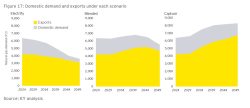Australia will still need substantial gas production 26 years from now to ensure reliable and affordable energy in 2050, even under a net zero scenario, according to The future role of natural gas in Australia and the region.
EY was commissioned by Australian Energy Producers to provide an independent assessment of the future role of natural gas in Australia and the region to inform Australia's Future Gas Strategy.
EY examined around 350 net zero pathways around the world and has recommended Australia should prepare for multiple gas production scenarios due to the uncertainty of the transition.
"Gas is expected to play a major role in the global net zero transition," the report said.
"Ongoing investment in gas supply is required to maintain production levels from operating fields. As these fields begin to decline, investment in new supply options will be required to meet projected demand.
"To manage the risks associated with the transition to net zero Australia's energy and climate mitigation policy needs to prepare for all three future scenarios, with policy and regulatory actions that keep as many pathways to net zero viable for as long as possible."
"Preparing for only one pathway leaves Australia extremely vulnerable to developments that are outside Australia's control."
Under the Electrify Scenario, domestic and regional demand for Australian gas would total 56 per cent of current production levels in 2050 after a renewable rollout equal to 20 times current levels.
Under the Blended Scenario, demand for Australian gas would increase to 2040 before decreasing to 86 per cent of current levels by 2050 as renewables grow to 13 times current levels.
Under the Capture Scenario, demand for Australian gas would rise 30 per cent from current levels by 2050 with a more limited renewable rollout at only 10 times current levels.

Australian Energy Producers Chief Executive Samantha McCulloch said: "The study shows gas is a safety net for Australia's energy transition, providing affordable and reliable energy for households and businesses.
"The inclusion of natural gas as a core pillar of Australia's energy and climate policies will speed up the transformation and secure substantial economic benefits from net zero."
The report found Australia's unique position serving growing Asian demand meant it had to chart its own course, capturing more of the global market and lowering emissions through supporting renewable roll-out and coal-to-gas switching.
The report noted that LNG represents "a significant export revenue opportunity for Australia across all three scenarios, even where LNG exports are complemented by low-carbon hydrogen exports over time."
Ms McCulloch added: "Australia needs to plan for both strong domestic and international demand for gas to secure the associated emissions reduction and economic opportunities.
"As well as keeping the lights on across Australia and the region, Australia's gas industry delivered over $16 billion of government revenues last financial year and spent another $45 billion with Australian businesses, all the while supporting tens of thousands of jobs across the economy.
The report found Australia's gas industry also had a critical role to play in rolling out net zero technologies and fuels including carbon capture, utilisation and storage (CCUS) and low-carbon hydrogen.
"CCUS and hydrogen are key complements to natural gas in a zero emissions future - all plausible net zero pathways involve CCUS and hydrogen at different scales," the report said.






